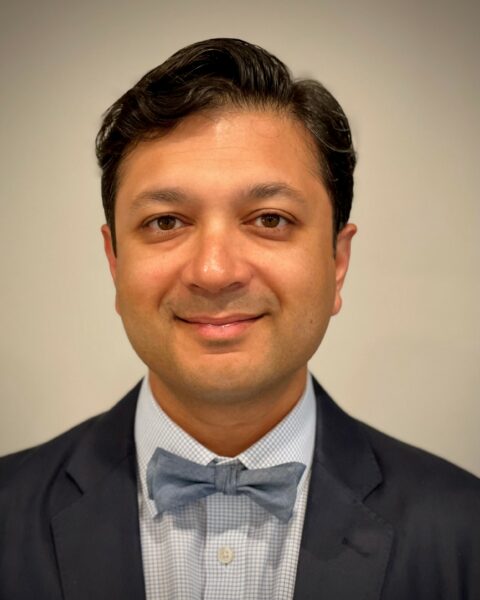Our board-certified sleep specialists, Kinjal Madhav, MD and Aman Savani, MD , consults with you regarding your particular sleep problems and interprets the data gathered from sleep studies administered by highly-trained technologists at our Carlsbad, California facility. They take this information and develop a personalized treatment plan in collaboration with you. We are committed to ongoing evaluation to ensure the treatment is effective and you are sleeping better. Call now to schedule your sleep consultation or sleep study at (760) 631-3000.
Physician
Dr. Madhav and Dr. Savani have experience in diagnosing, treating and managing various sleep disorders including sleep apnea, narcolepsy, restless legs syndrome, REM behavior disorder, insomnia and parasomnias.
To learn more about sleep disorders, please visit the National Sleep Foundation.
The Importance of Sleep
 Getting a good night’s sleep – it’s something we all want and need. Our outlook on life and daytime productivity depend on it. Our health is impacted by it. But when we don’t sleep well over time, it affects our lives in a big way. The staff at The Sleep Center are committed to improving this important aspect of your life. From evaluation of your sleep, to diagnosis of your sleep disorder, to treatment options, and ongoing care, we want to work with you to make sure you have the opportunity for a good night’s sleep!
Getting a good night’s sleep – it’s something we all want and need. Our outlook on life and daytime productivity depend on it. Our health is impacted by it. But when we don’t sleep well over time, it affects our lives in a big way. The staff at The Sleep Center are committed to improving this important aspect of your life. From evaluation of your sleep, to diagnosis of your sleep disorder, to treatment options, and ongoing care, we want to work with you to make sure you have the opportunity for a good night’s sleep!
The Sleep Center consults with you regarding your particular sleep problems. Common sleep complaints include snoring, insomnia, non-refreshing sleep, day time sleepiness, morning headache, and restless leg syndrome. Often it is the bed-partner who notices you snore or are restless during sleep. Did you know that one of the most common sleep disorders, obstructive sleep apnea, increases your risk of hypertension, heart disease, and stroke? Sleepy drivers are at risk of car crashes. Productivity at work and home may suffer.
Sleep is important for both physical and mental health. More than 25% of Americans report problems with sleep or daytime alertness. People who suffer from disordered sleep report lower quality of life, impaired job performance, and have higher rates of mood disorders. Despite the negative consequences of sleep disorders most people remain untreated.
What is insomnia?
Insomnia is a common sleep disorder that is characterized by difficulty:
- Falling asleep initially.
- Waking up during the night.
- Waking earlier than desired.
Insomnia symptoms occur in approximately 33% to 50% of the adult population while Chronic Insomnia disorder that is associated with distress or impairment is estimated at 10% to 15%.
Insomnia occurs more often in women than in men. Pregnancy and hormonal shifts can disturb sleep. Other hormonal changes, such as premenstrual syndrome (PMS) or menopause, can also can affect sleep. Insomnia becomes more common over the age of 60. Older people may be less likely to sleep soundly because of bodily changes related to aging and because they may have medical conditions or take medications that disturb sleep.
Symptoms:
- Difficulty falling asleep and/or waking up in the middle of the night.
- Difficulty returning to sleep.
- Feeling tired/fatigued during the daytime.
- Irritability or depressed mood.
- Problems with concentration or memory
What are the consequences of insomnia?
When you can’t fall asleep or your rest is fitful, you may:
- Be irritable, anxious or depressed.
- Feel fatigued or low on energy throughout the day.
- Have memory problems or difficulty concentrating.
- Struggle at work, school or in relationships.
It can also increase your risk for:
- Diabetes.
- Driving accidents, injuries and falls.
- High blood pressure (hypertension), heart disease and stroke.
- Mood disorders.
- Weight gain and obesity.
What is Obstructive Sleep Apnea (OSA)?
Obstructive sleep apnea is a common and underdiagnosed condition which negatively affects one’s health and well being. Approximately 10% of men and 5% of women have OSA. OSA is caused by episodes of upper airway closure when asleep.
When we sleep at night all the muscles of the body relax. This includes the muscles of the upper airway. In susceptible individuals this can lead to upper airway narrowing & closure. Snoring is caused by vibration of the upper airway tissues when asleep. Snoring by itself is a cosmetic disorder that does not negatively affect ones health (though it may disrupt the sleep of ones bed partner!) Most people with OSA snore but not every one who snores has OSA.
In people with obstructive sleep apnea the airway muscles relax too much when asleep so that the airway becomes partially or completely blocked for several breaths. (Please see figure) As a result of the obstructed airway airflow to the lungs is reduced which decreases oxygen delivery to the bloodstream. When this occurs the brain arouses out of sleep as a protective mechanism. It sends strong signals to the airway muscles to open up, and a person resumes breathing normally. The person usually falls back asleep within several seconds unaware of the sleep disruption. However, this fragmentation of sleep leads to many of the daytime symptoms of OSA.
OSA Symptoms
Often the first signs of OSA are recognized not by the patient, but by the bed partner. Many of those affected have no sleep complaints. The most common signs and symptoms of OSA include:
- Snoring.
- Daytime sleepiness or fatigue.
- Restlessness during sleep, frequent nighttime awakenings.
- Sudden awakenings with a sensation of gasping or choking.
- Dry mouth or sore throat upon awakening.
- Cognitive impairment, such as trouble concentrating, forgetfulness or irritability.
- Mood disturbances (depression or anxiety).
- Night sweats.
- Frequent nighttime urination.
- Sexual dysfunction.
- Headaches.
People with central sleep apnea more often report recurrent awakenings or insomnia, although they may also experience a choking or gasping sensation upon awakening.
What are the consequences of OSA?
Untreated OSA can cause and worsen hypertension, an irregular heart rate such as atrial fibrillation, heart failure, coronary artery disease and stroke. Treatment of OSA has been shown to reduce the risk of developing these health conditions and often improves them if they exist. Treatment of OSA may improve glucose control in diabetics as well.
OSA Risk Factors
The following factors may increase for your risk for OSA:
- Male gender
- Obesity, neck circumference over 17 inches in men
- Advanced age
- Woman who are post menopausal are twice as likely to develop OSA.
- Having a first degree relative with OSA doubles ones risk of having this condition.
- More than half of people who have suffered stroke have sleep apnea and it is estimated that approximately one half people with atrial fibrillation and/or heart failure have OSA.
How do you diagnosis sleep apnea?
If your doctor determines that you have symptoms suggestive of sleep apnea, she may order diagnostic testing including a polysomnogram (PSG) which is an overnight sleep study or a home sleep test (HST).
What are the treatments for sleep apnea?
Conservative treatments include:
- Weight loss
- Avoiding alcohol and other sedative medications
Mechanical ventilation therapy:
- Positive Airway Pressure (PAP) therapy is the preferred initial treatment for most people with obstructive sleep apnea. With PAP therapy, patients wear a mask over their nose and/or mouth. An air blower gently forces air through the nose and/or mouth.
Oral appliance therapy:
- Dental appliances or oral mandibular advancement devices that help to prevent the tongue from blocking the throat and/or advance the lower jaw forward can be made.
Surgical treatments include:
- Non-anatomy modifying: Inspire Therapy (hypoglossal nerve stimulator)
- Dr. Madhav is trained and experienced in Inspire therapy. To learn more, please visit the Inspire Therapy website.
- Anatomy modifying: Surgical options are suggested in more complex cases of sleep apnea or refractory to other treatments.

